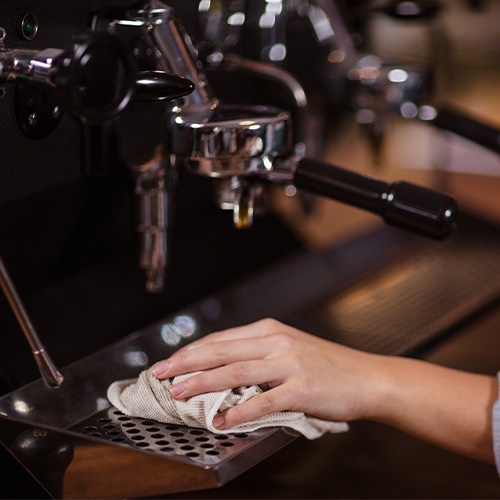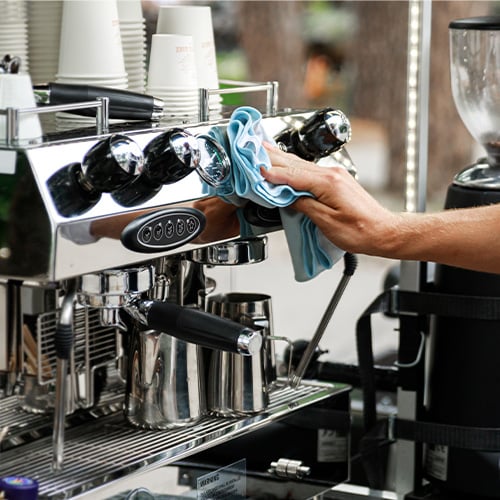
Espresso is a popular drink ordered in coffee shops. Due to the drink's demand, espresso machines are an essential part of any establishment that serves coffee. For the best results, you must clean and maintain your machine regularly. Not only does this ensure quality espresso, but it also keeps your machine in good condition for the long run. Whether you've just invested in one of the best espresso machines on the market or have had your current unit for years, staying up-to-date on the correct cleaning methods is essential. We'll outline how to do so, the tools you'll need, and other maintenance tips.
Shop All Commercial Espresso MachinesEspresso Machine Cleaning Tools

No matter what type of espresso machine you have, you must invest in the proper cleaning tools to maintain it. Some components and cleaning procedures require specialized tools, and without them, you won't be able to do a proper job. Using the wrong tools can cause long-lasting damage to the unit or result in costly repairs. If you own an espresso machine for your business, be sure to invest in the following tools:
- Multi-use coffee tool: These tools scrub the various components of your espresso machine, such as the portafilter and group head. They often include a brush and other attachments to offer a complete clean.
- Espresso cleaning detergent: This specialized detergent is formulated to break down and remove stubborn coffee oils and residue from the inside of your machine.
- Microfiber cloth: Microfiber cloths are gentle on the machine's surface and effectively remove dust, dirt, and fingerprints.
- Stubby screwdriver: A stubby screwdriver is a handy tool for removing and reattaching components of your machine.
Cleaning an Espresso Machine

When it comes to cleaning the inside of an espresso machine, the most common method is a process called backwashing. Using this method, you'll flush hot water and detergent through the unit to remove coffee residue. Key components that backflushing helps to clean include the shower screen, brew group, and valve. It's important to note that backflushing is only for espresso machines equipped with a three-way valve, as it allows for the release of pressure from the coffee puck after extraction. Although it may seem complicated, backflushing your unit is easy once you get the hang of it. To backflush an espresso machine, follow these steps:
- Pre-scrub: Start by scrubbing and removing the group screen to ensure no residue remains that could affect the flavor of your espresso.
- Attach the blind filter: Remove the filter basket and attach a blind filter in its place.
- Add cleaning product: Add half a teaspoon of espresso machine cleaner to the blind filter.
- Prepare to flush: Lock the filter into the group and activate the brew switch to begin cleaning.
- Release: Lower the lever to release the machine's contents. You should see a soapy or foamy mixture coming out.
- Repeat: Wait for about five seconds and repeat the process. This step helps thoroughly clean the internal components of the machine. Continue repeating the process 3-5 times until the machine appears free of buildup.
- Dispose of debris: After the final cleaning cycle, remove the portafilter and dump its contents into the drip tray.
- Rinse: Repeat steps 4-6 without using a cleaning product to rinse the unit. Rinse out any remaining detergent from the portafilter. Flip the group head to ensure all areas are clean.
- Repeat: Next, repeat the cleaning process 3-5 more times without using any detergent. This step helps to flush out any remaining residue from the machine.
- Flush: Remove the portafilter and do one final flush from the group to ensure the machine is clean and ready for use.
Espresso Machine Maintenance Checklist

Creating a daily maintenance checklist will ensure you and your staff pay proper attention to your espresso machine and its maintenance needs. Not only does following a daily maintenance routine prolong the life of your machine, but it ensures it is ready to go for the next day. Remember to check in with your staff and make sure they communicate when and what they did to maintain the machine to ensure workplace efficiency. As you create your maintenance checklist, be sure to include the following tasks:
- Clean, wipe down, and purge the steam wand: To prevent obstructions and maintain quality steam production, clean and wipe down the steam wand after each use to ensure proper functionality.
- Flush the group head before each round of espresso: Before pulling a shot of espresso, flush the group head with water to remove any built-up oils and coffee grounds.
- Regularly wash your cleaning cloths: Cloths used to wipe down the machine, steam wand, and countertops should be washed to prevent the accumulation of bacteria.
- Clean the draining hose: Regularly clean the draining hose to avoid clogs and ensure proper water and waste drainage.
- Clean portafilters, filter baskets, and drip trays: These components come into direct contact with coffee grounds and water while making espresso. As such, they should be regularly cleaned to maintain the quality and flavor of your beverages.
Back to Top
Adding espresso to your selection of coffee drinks is an easy way to satisfy customers and boost profits. By regularly cleaning your espresso machine, you can promote long-lasting performance, high-quality drinks, and efficient brewing. Whether you've been in the coffee industry for years or just started, knowing how to clean and maintain your unit is a must. By adhering to the tips above, you can keep your machines well-maintained and ready to meet your output needs.





